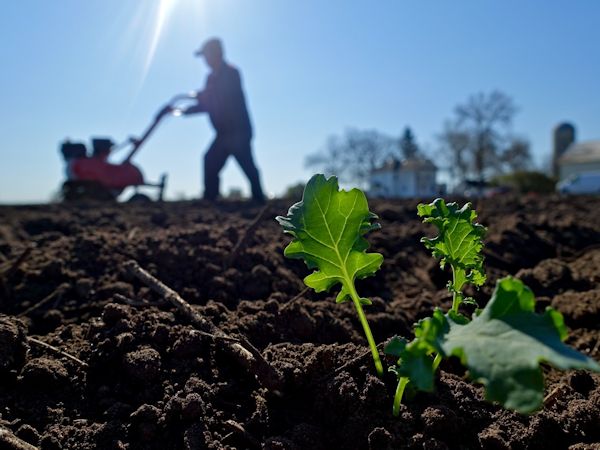SEJournal Online is the digital news magazine of the Society of Environmental Journalists. Learn more about SEJournal Online, including submission, subscription and advertising information.
 |
| Kale, long considered a healthy and nutritional food, has ended up on a “Dirty Dozen” list of items with high pesticide residues. Photo: By Media Mike Hazard, Flickr Creative Commons. Click to enlarge. |
TipSheet: Want Pesticides with That Kale?
Kale has acquired a hallowed reputation as a health food among hipsters and millennials. Just don’t automatically assume that it’s good for you. That’s because the leafy green has made at least one environmental group’s “Dirty Dozen” list for, wait for it, pesticide contamination.
The Environmental Working Group, a green advocacy group that loves data and specializes in food and pesticide issues, puts out an annual list of the “Dirty Dozen” produce items with the highest pesticide residues — as well as a “Clean Fifteen” list for the lowest.
Kale made that list this year for the first time. We rush to note that kale is quite high in important nutrients, which is one reason it has become fashionable. If you buy organic kale, properly certified, you will get the nutrients with virtually none of the pesticides. So don’t stop eating kale if you enjoy it, but maybe you should buy your kale from an organic vendor.
By the way, the good news is that the avocado you spread on your toast is on the “Clean Fifteen” list.
The backstory
The kale story is really just a gateway to a broader realm of food and chemical health and safety stories that environmental journalists can, er, fruitfully explore.
The use of chemicals on food goes back many years. The first version of the Federal Insecticide, Fungicide, and Rodenticide Act, or FIFRA, was enacted way back in 1910 — although its original purpose was not to protect consumers against toxics but to protect farmers against bogus chemicals.
Congress has amended it many times since then, eventually with some intent of protecting the environment and public health.
Farmers apply many pesticides because they increase yields by reducing insects and other pests that may harm or kill crops. Pesticide use in some cases protects against catastrophic crop loss. In other cases it improves the marketability of food by reducing cosmetic blemishes.
The publication of Rachel Carson’s “Silent Spring” in 1962 marked an eventual turning point in U.S. law and policy about pesticides — but not without a battle by the chemical and agriculture industries.
Today, FIFRA requires the U.S. Department of Agriculture to sample the amount of pesticide to be found on foodstuffs and produce (“residues”). It also requires the U.S. Environmental Protection Agency to set scientific health-based limits (“tolerances”) for the amount of pesticide that is allowed on a particular food product.
Why it matters
Scientists today know that many historically used pesticides can do serious harm to human health (much less the environment).
Direct exposure to some pesticides, such as those in the organophosphate family, can cause neurological symptoms similar to nerve gas, including death.
Other commonly used pesticide families can cause reproductive harm and cancer via chronic exposure at much lower levels — including by ingestion of food.
Ostensibly, the goal of the food system is to minimize or eliminate human exposure to pesticide residues. Today, instruments can measure contamination in parts per trillion.
Toxicology teaches that “the dose makes the poison” — the less we are exposed to, the less the harm. So when there are pesticides in our food, it matters greatly what pesticide and how much, as well as how often we are exposed over time.
Story ideas
EWG’s “Dirty Dozen” list can be a starting point for many other stories of interest to your audience.
- How much USDA organic food is found in your local supermarkets? Is it well labelled? How do prices compare? How is it certified?
- Visit your local farmers’ markets. Talk to the vendors and managers. What will vendors tell you about how they use pesticides on their produce? Or not. Are they organic?
- Which foods in your markets are local and which come from farther away? Can you visit the farms of origin to observe pesticide practices?
- What fruits and vegetables are grown near you? What pests threaten them? How are local farmers responding?
- What fruits or vegetables in your supermarket are imported from other countries? How well are these sampled and inspected for pesticide residues?
Reporting resources
Some further sources of information:
- USDA’s Pesticide Data Program. It has a searchable online database and an app. The latest “annual” report, for 2017, was released in 2018.
- The EPA is the main federal agency regulating the health aspects of pesticides. It sets the tolerances for specific pesticides on specific foods.
- EWG’s “Shopper’s Guide to Pesticides in Produce 2019.” While EWG puts it out annually, the data come from multiple years of past USDA reports.
- Beyond Pesticides: A group that advocates for safer use of pesticides or their outright elimination.
- CropLife America: The lobbying arm of the pesticide industry.
- Your state pesticide regulatory agency. State agencies usually do much of the day-to-day regulatory work.
- Organic Consumers Association: A nonprofit that advocates for organic food alternatives, and represents the growing organics industry.
- National Pesticide Information Center: Run by Oregon State University and EPA, and offering science-based information.
* From the weekly news magazine SEJournal Online, Vol. 4, No. 14. Content from each new issue of SEJournal Online is available to the public via the SEJournal Online main page. Subscribe to the e-newsletter here. And see past issues of the SEJournal archived here.












 Advertisement
Advertisement 



